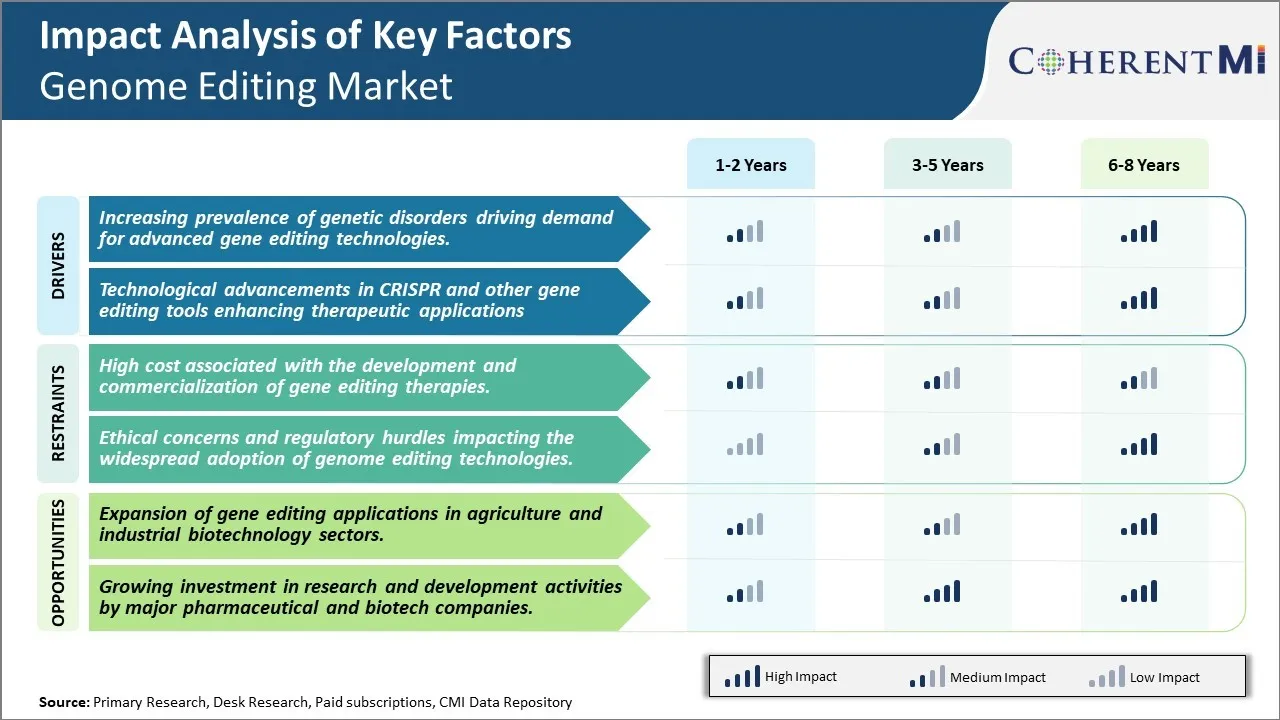Genome Editing Market Trends
Market Driver - Increasing Prevalence of Genetic Disorders Driving Demand for Advanced Gene Editing Technologies
According to recent estimates by health organizations, over 7000 genetic disorders have been identified affecting nearly 10% of the global population in some form. Some of the common genetic disorders include Cystic fibrosis, Sickle cell anemia, Tay-Sachs disease, Fragile X syndrome, Hemophila, and different other types of cancers.
Gene editing technologies are now emerging as a game changing treatment approach for genetic diseases. They allow correction of the underlying disease-causing mutations directly in the patient's genomic DNA. Revolutionary tools like CRISPR-Cas9 provide an efficient way to precisely modify genes and have potential to cure genetic diseases at their root cause. This is driving tremendous interest from biotech companies and researchers towards developing gene therapies based on editing technologies.
The demand is especially strong from patients suffering from genetic conditions with high unmet medical needs. For instance, Beta thalassemia requires lifelong blood transfusions which have several complications. Gene therapies can help eliminate this ongoing treatment regimen. Similarly, some rare genetic disorders affecting children often lead to intellectual and physical disabilities or even death due to lack of therapies. All these factors are propelling strong growth in the application of gene editing for the treatment of hereditary diseases.
Market Driver - Technological Advancements in Crispr and Other Gene Editing Tools Enhancing Therapeutic Applications
CRISPR/Cas9 system has emerged as the most popular technology due to its ease of use and high precision. However, continuous innovations are helping address various challenges associated with CRISPR like off-target effects. Novel CRISPR enzymes with improved specificity profiles are being discovered which enhance gene editing accuracy. Delivery methods for CRISPR are also undergoing refinements. For instance, use of nanoparticles, viral vectors, and cell-penetrating peptides allows more efficient intracellular delivery of CRISPR components.
Apart from CRISPR, other genome editing platforms including TALENs, meganucleases, and base editors are also witnessing new versions with improved characteristics. For example, advances like prime editing and hyper editor increase the scope and flexibility of genomic alterations that can be achieved. At the same time, new modalities like CRISPRa/CRISPRi allow regulation of gene expression without permanent DNA changes, giving versatile applications. Further, simplified kits and reagents are making genome editing procedures more user-friendly for lab experiments and eventual clinical use.
Such technological leaps expand the types of diseases which can be effectively treated. Overall, continuous innovations in design and delivery of gene editing systems are enhancing precision and scope of their therapeutic applications in significant ways.

Market Challenge - High Cost Associated with Development and Commercialization of Gene Editing Therapies
One of the major challenges faced by the genome editing market is the exceedingly high cost associated with the development and commercialization of gene editing therapies. Bringing a new gene therapy to the market involves extensive research and development spanning many years. The process involves discovering and validating gene targets, designing custom endonucleases and vectors for delivery, conducting rigorous pre-clinical testing for safety and efficacy, followed by several phases of clinical trials in human volunteers. Each of these stages requires considerable financial investments running into hundreds of millions of dollars.
Additionally, genome editing therapies often need to be tailored to individual patients, further escalating costs. Manufacturing gene therapies also poses unique challenges considering the need for highly specialized facilities and stringent manufacturing controls. The cost of setting up Good Manufacturing Practice compliant facilities and establishing robust production processes is prohibitively high. Overall, the total cost of developing and launching a single gene therapy has been estimated to cross over USD $1 billion. The heavy burden of costs poses a major hurdle for widespread adoption of gene editing technologies in medicine.
Market Opportunity - Expansion of Gene Editing Applications in Agriculture and Industrial Biotechnology Sectors
One of the key opportunities for the genome editing market lies in the expansion of its applications in the agriculture and industrial biotechnology sectors. In agriculture, gene editing tools are being utilized to develop crop varieties with higher yields, improved resilience to biotic and abiotic stresses and better nutritional qualities. This can help address the growing challenges of food insecurity. Genome editing allows precise modifications to be made without introducing foreign DNA, thus avoiding complex regulatory issues.
Several trait proofs-of-concept studies have demonstrated the potential of CRISPR-Cas9 in important crops like rice, wheat and soybean. Leading biotech companies are investing heavily in scaling up these innovations. In industrial biotechnology, gene editing is enabling the development of microorganisms tailored for more efficient production of biofuels, chemicals and enzymes. It can facilitate the generation of designer cell lines providing advantages such as higher productivity, optimized metabolic pathways and improved tolerance.
As the technology matures, its widespread adoption in agri-food and industrial sectors has potential to generate significant economic and social value globally.